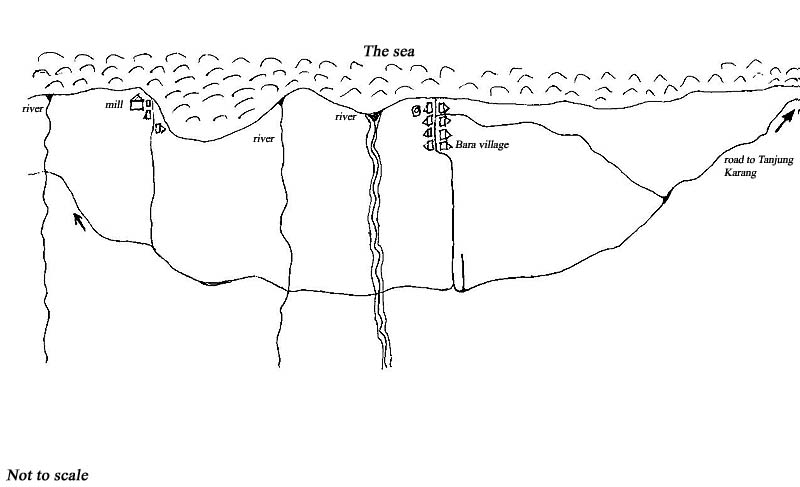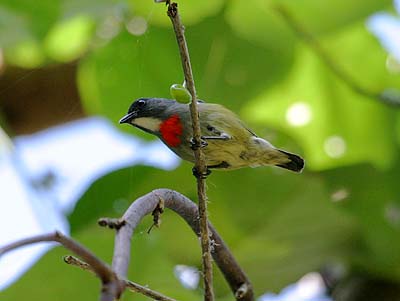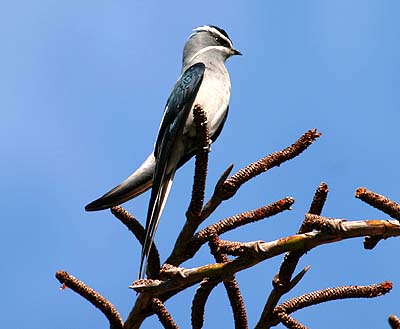Photos with this report (click to enlarge) | |||
 Map |
 Flame-breasted Flowerpecker |
 Moustached Tree-swift |
|
I tried to get to the island of Buru twice before this trip but could not for different reasons, the first attempt was just after an earthquake which hit the island and foreigners weren’t allowed to travel to the island, the second time I just was not able to get a plane ticket. This time I was determined to get to the island by any means possible. The reason why I decided to visit the Island was to find out more about 2 species, the Blue-fronted Lorikeet (Charmosyna toxopei) and the Black-lored Parrot (Tanygnathus gramineus). Even though Buru Island is not rich in species it still holds some of the rarest and less known species on the planet.
Introduction
The islands of Maluku known as the Spice Islands are part of Wallacea thus the fauna and flora is a mix of Asian and Australasian species. Ambon is the capital city and the centre of this region, the perfect place to use as the base for exploring the surrounding islands. There are still many islands not birded properly and one of them is Buru. Buru is a large mountainous island (8 613 square km), the highest point at 2428 m is Gunung Kelapamada, found in the northwest of the island. It was proposed as a protected Game Reserve as it is an important area with some of the remaining undisturbed forest on the island.
There are still patches of pristine forests present on the island especially in the west though most of the lowlands have now been cleared by slash and burn agriculture.
There is more information on the island fauna and flora on the National Geographic Society website (http://www.worldwildlife.org/wildworld/profiles/terrestrial_aa.html).
Most of the inhabitants of the villages on the South side of the island are Christian and on the north Muslims. Bara is a Muslim village and I was surprised at the abundance of wild pig and flying fox in the surrounding forest.
According to the guides they are spared as the people of the village don’t eat the meat, the same thing for the Spotted Whistling ducks we found in the mangroves. Dogs are not allowed in Bara.
When I asked the locals about any Foreigners that may have come previous to my arrival, I was informed of two groups, one German, and one Dutch, in 1994 and in 1996, that had visited for the purpose of collecting butterflies, insects, and lizards.
Logistics
By air: It’s not difficult to get to Ambon from all major cities in Indonesia such as Jakarta, Denpasar, Makassar or Manado. I won’t get into details about that. Merpati Nusantara operates Twin otters from Ambon to nearly all the islands in Maluku or Wallacea, to Namlea every Sunday, not to be counted on as it’s always fully booked if not booked minimum 2 weeks in advance. With luck and if the seas are calm one may find available seats because it’s cheaper for the locals to take boats. Merpati office in Ambon is found on Jl. A.Yani, No.19, phone: (0911) 342488, fax: (0911) 52572.
After landing on Namlea one should book return ticket to Ambon straight away otherwise the risk of not getting one when it’s time to leave the island is big.
By sea: There is a daily fast ferry (Kapal Cepat) from Ambon to Namlea; it takes about 4 to 5 hours depending on the weather and the waves. The price is 155.000rp (around 12 euros).
There is another ferry that runs between Ambon and Leksula on the South of the island twice a week. There is also the big Pelni ferry, but this one covers this distance once a month or so on its way to Sulawesi and it’s highly unreliable, I didn’t bother to get information about it. One can charter a small speed boat to get to Buru Island if money and time are not a problem.
On the north side of the island there is a road connecting most major villages such as Sawa, Waeputih and Wasamparo ending at Airbuaya, after the latter all traffic is done by motorcycles or big trucks. There are many river crossings which can be dangerous during the wet season.
There are some dirt roads connecting the villages on the south otherwise all transportation is done by small boats.
Report in brief:
The Lion Air flight from Yogyakarta to Ambon took about 5h30mins. The taxi from the airport to the city is not cheap (150.000rp). I checked in at Wisma Grace hotel at the back of hotel Amans, a cheaper alternative, very clean and good service (170.000rp for a d-room with AC and TV, breakfast included). There is a good and cheap restaurant on the top floor.
The hotel is in the centre of the city, close to market and the harbour. After a lunch of tuna steak and rice I went to the Merpati office to book a ticket. The two next flights to Namlea were fully booked, I put my name on the waiting list for the first flight and left for the Harbour. I asked around about the boat or ferry to Namlea, I was not surprised to get many different answers and one of them was that there is a fast ferry at Sudarso station.
Yes, there is a fast boat which leaves Ambon for Buru at 14.30pm daily, this information I got from the ticket office at Sudarso station.
The next day I was at the station in time, many people with a huge amount of baggage from chicken to fridges and TV sets…everything was loaded on board.
We left Ambon at 14.30pm and after a rough journey which lasted 4h30min we arrived to Namlea at sunset. Many motorcycles were waiting for customers to drive to the city.
I chartered one and asked to be taken to a clean hotel.
Hotel Grand Sarah is up on a hill overlooking the city, it’s where the president of Indonesia stays when visiting the Island. The prices weren’t that bad, 200.000rp (22 USD) for a standard room with AC, TV and warm water.
I arranged for a taxi-charter for the next day to take me to the N-West region on the island, as far as the road goes. If I could get to Bara village or further I will be pleased. According to the taxi driver it shouldn’t be a problem. I decided that we’ll leave at 05.00am, no time to waste.
That same evening I went to the police station to announce my arrival and my intentions. It was decided that a policeman will travel with me to where I’ll be staying the next couple of days and makes sure that everything is in order. It’s a safety issue.
We left the hotel at 05.10am, it was still dark and I was hoping for some owls and nightjars along the road. We stopped few times when we heard owls and saw nightjars flying in front of the car.
The road to Airbuaya (108 km) was fairly good with some patches of dirt. We were informed at the police station in this city that it was impossible to continue to Bara village by car due to the bad state of the road and the presence of many difficult river-crossings (no bridges). By motorcycles we should be able to cover the rest of the journey.
I chartered 3 motorcycles, one for the policeman, one for me and the last one for my baggage. It’s 38 km to our destination from Airbuaya, quite rough at places. There are many small river crossings and it is impossible to cross without the help of locals who earn money by taking people and transports to the other side on a wooden platform.
We arrived at Bara around 03.20pm, we stopped at the house of the head of village (kepala desa) and I asked him if it was possible for me to stay in his village for a week or so. There was no problem there and even offered me a room in his house. I paid the guys and gave some money to the policeman for buying cigarettes, he returned to Airbuaya with the others.
Nobody speaks English in this place so my knowledge in the Indonesian language is one reason why I can travel to any part of the country without problems. You can get very close to the locals if you can talk to them in their native language.
I gave some money to the lady of the house for buying food supplies.
I was curious about the birds in this region so I decided to head for the forest close by, I was joined by 2 local guys who knew where the nearest trails were and nothing about the birds.
We didn’t venture far, many bird species seen such as Flame-breasted Flowerpecker, Superb Fruit-Dove, Black-faced Friarbird, a flock of Claret-breasted Fruit-Doves, Brown Cuckoo-Dove, Red-cheeked and Great-billed Parrots, Olive-backed and Black Sunbirds……
The birding during the next 6 days is done in 3 different places, about 8 km east and 9 km west of the village and on the sea shore.
The last 2 days in Buru island were spent birding the surroundings of Namlea city, there is a good trail close to the harbour, easily reached with a motorcycle for 5 to 10.000rp. No forest just gardens.
There is some lowland forest in this region but the huge tall trees are long gone. Major logging companies have built a 6 meters wide road to facilitate the transportation of wood to the coast where a huge wood mill takes care of the rest.
The slash and burn method is used by the farmers to clear the land for cultivation of crops such as Cacao. I talked to a farmer about their earnings. One Cacao tree produces about 5 kg of Cacao beans, when dried they are sold in the Sanana in the Sulas and sold for 10.000rp/ kg.
This is the reason why the forest is cleared rapidly; the farmers need to plant many Cacao trees if they’re going to make a living from the crops. Besides farming fishing is important for earning a living. Fish are sold to the Japanese ships that make many stops in the region.
Around Bara
The steep hills and mid-mountains start directly south of the logging road about 1 to 1,5km south of the village, the best trails to higher grounds run along the river-beds in the dry season, during the rainy season the rivers are flooded otherwise it is very difficult to find suitable trails to the mountain forests.
Forest at Bara
Some good grassland and monsoon forest are found east of the village.
The gardens close to the sea are good places for watching the parrot species especially the Red-cheeked the Great-billed and the Eclectus.
The best birding is, as anywhere else, very early in the morning and late in the afternoon.
Some bird species can be encountered at any time such as birds of prey, wood-swallows, bee-eaters, kingfishers…..
The steep hills and mid-mountains start directly south of the logging road, the best trail higher up is along with the river-bed in the dry season, during the rainy season the rivers are flooded.
Some good grassland and monsoon forest are found east of the village.
Conclusion
Because of health problems I couldn’t get the best of the trip as I planned it, I didn’t spend as much time as I wanted to thus I couldn’t visit different places and just focused on one. In general I’m very satisfied with my experience on the island and I did manage to see and record the sound of what I believe is Charmosyna toxopei. I know where I can find them and the next trip will be to get photographs.
I would like to thank my wife Lena, Steve Pryor (List of Buru birds) and Rasmus Boegh for their help and support. Questions and critics are welcomed (mehd_halaouate@yahoo.se).
Moluccan Megapode - Eulipoa wallacei
Orange-footed Megapode - Megapodius reinwardt reinwardt
Spotted Whistling Duck - Dendrocygna guttata
Radjah Shelduck - Tadorna radjah radjah
Yellow Bittern - Ixobrychus sinensis
Rufous Night Heron - Nycticorax caledonicus hilli
Cattle Egret - Bubulcus ibis coromandus
Great Egret - Ardea alba modesta
Little Egret - Egretta garzetta nigripes
Pacific Reef Egret - Egretta sacra sacra
Great Frigatebird - Fregata minor minor
Lesser Frigatebird - Fregata ariel ariel
Little Pied Cormorant - Phalacrocorax melanoleucos melanoleucos
Little Black Cormorant - Phalacrocorax sulcirostris
Darter - Anhinga melanogaster melanogaster
Spotted Kestrel - Falco moluccensis moluccensis
Oriental Hobby - Falco severus papuanus
Osprey - Pandion haliaetus cristatus
Pacific Baza - Aviceda subcristata stresemanni
Black Kite - Milvus migrans affinis
Brahminy Kite - Haliastur indus girrenera
White-bellied Sea Eagle - Haliaeetus leucogaster
Variable Goshawk - Accipiter novaehollandiae pallidiceps
Rufous-necked Sparrowhawk - Accipiter erythrauchen ceramensis
Buff-banded Rail - Gallirallus philippensis mellori, philippensis
Purple Swamphen - Porphyrio porphyrio melanopterus
Dusky Moorhen - Gallinula tenebrosa frontata
Common Coot - Fulica atra lugubris
Beach Thick-knee - Esacus neglectus
Pacific Golden Plover - Pluvialis fulva
Greater Sand Plover - Charadrius leschenaultii leschenaultii
Whimbrel - Numenius phaeopus variegatus
Wood Sandpiper - Tringa glareola
Common Sandpiper - Actitis hypoleucos
Lesser Crested Tern - Sterna bengalensis torresii
Greater Crested Tern - Sterna bergii cristata
Black-naped Tern - Sterna sumatrana sumatrana
Common Tern - Sterna hirundo longipennis
Little Tern - Sterna albifrons sinensis
Rock Dove - Columba livia
White-throated Pigeon - Columba vitiensis halmaheira
Spotted-necked Dove - Streptopelia chinensis tigrina
Brown Cuckoo-Dove - Macropygia amboinensis amboinensis
Great Cuckoo-Dove - Reinwardtoena reinwardtii reinwardtii
Emerald Dove - Chalcophaps indica indica
Pompadour Green Pigeon - Treron pompadora aromaticus
Superb Fruit Dove - Ptilinopus superbus superbus
White-bibbed Fruit Dove - Ptilinopus rivoli prasinorrhous
Claret-breasted Fruit Dove - Ptilinopus viridis viridis
White-eyed Imperial Pigeon - Ducula perspicillata perspicillata
Blue-tailed Imperial Pigeon - Ducula concinna
Pied Imperial Pigeon – Ducula bicolor bicolor
Red-breasted Pygmy Parrot - Micropsitta bruijnii pileata
Red Lory - Eos rubra cyanonotha
Rainbow Lorikeet - Trichoglossus haematodus haematodus
Blue-fronted Lorikeet - Charmosyna toxopei endemic
Red-cheeked Parrot - Geoffroyus geoffroyi rhodops
Buru Racquet-tail - Prioniturus mada endemic
Great-billed Parrot - Tanygnathus megalorynchos affinis
Eclectus Parrot - Eclectus roratus roratus
Moluccan King Parrot - Alisterus amboinensis buruensis
Oriental Cuckoo - Cuculus saturatus saturatus
Rusty-breasted Cuckoo – Cacomantis sepulcralis aeroginosus
Common Koel - Eudynamys scolopaceus orientalis
Channel-billed Cuckoo - Scythrops novaehollandiae novaehollandiae
Lesser Coucal - Centropus bengalensis medius
Lesser Masked Owl - Tyto sororcula cayelii
Moluccan Scops Owl - Otus magicus magicus
Large-tailed Nightjar - Caprimulgus macrurus schlegelii
Glossy Swiftlet - Collocalia esculenta esculenta
Moluccan Swiftlet - Aerodramus infuscatus ceramensis
Uniform Swiftlet - Aerodramus vanikorensis moluccarum
Fork-tailed Swift – Apus pacificus pacificus
Moustached Treeswift - Hemiprocne mystacea confirmata
Dollarbird - Eurystomus orientalis pacificus
Collared Kingfisher - Todiramphus chloris chloris
Sacred Kingfisher - Todiramphus sanctus sanctus
Common Kingfisher - Alcedo atthis bengalensis
Rainbow Bee-eater - Merops ornatus
Red-bellied Pitta - Pitta erythrogaster rubrinucha
Black-faced Friarbird - Philemon moluccensis moluccensis
Buru Honeyeater - Lichmera deningeri endemic
White-breasted Woodswallow - Artamus leucorynchus leucopygialis
Buru Cuckoo-shrike - Coracina fortis endemic
Cicadabird - Coracina tenuirostris amboinensis
Pale Cuckoo-shrike - Coracina ceramensis ceramensis
Drab Whistler - Pachycephala griseonota examinata
Spangled Drongo - Dicrurus bracteatus buruensis
Willie-wagtail - Rhipidura leucophrys melaleuca
Northern Fantail - Rhipidura rufiventris bouruensis
Island Monarch - Monarcha cinerascens cinerascens
Black-tipped Monarch - Monarcha loricatus endemic
Moluccan Flycatcher - Myiagra galeata buruensis
Slender-billed Crow - Corvus enca violaceus
Barn Swallow - Hirundo rustica gutturalis
Pacific Swallow - Hirundo tahitica javanica
Golden-headed Cisticola - Cisticola exilis rusticus
Golden Bulbul - Thapsinillas affinis mystacalis
Chestnut-backed Bush Warbler - Bradypterus castaneus disturbans
Clamorous Reed Warbler - Acrocephalus stentoreus sumbae
Buru White-eye - Zosterops buruensis endemic
Shining Starling - Aplonis metallica metallica
Moluccan Starling - Aplonis mysolensis mysolensis
Flame-breasted Flowerpecker - Dicaeum erythrothorax erythrothorax
Black Sunbird - Leptocoma sericea proserpina
Olive-backed Sunbird - Cinnyris jugularis buruensis
Eurasian Tree Sparrow - Passer montanus malaccensis
Black-faced Munia - Lonchura molucca.